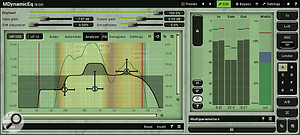I’m recording a singer whose pitch is pretty good, but on higher notes the sound gets a little harsh. Looking at the waveform on an spectrum analyser, I see that the harmonics (first octave up, etc.) have as much amplitude as the main note. I am EQ’ing a bit to make it sound less harsh, successfully to some degree, but I was just wondering whether it’s unusual for harmonics in the sung word to be as loud or even louder than the actual note?
Mike Senior
Tim Jacobs, via email

A dynamic equaliser such as Melda’s MDynamicEQ is one of the best tools for dealing with the harsh–sounding single–frequency resonances generated by some singers.A dynamic equaliser such as Melda’s MDynamicEQ is one of the best tools for dealing with the harsh–sounding single–frequency resonances generated by some singers.SOS Contributor Mike Senior replies: Not at all. The main reason is that vowel sounds are generated by creating quite powerful resonances in the throat, nose and mouth, and a harmonic can easily overpower a pitched note’s fundamental under such circumstances. In my experience, this also tends to happen more often when the singer is straining for higher pitches or simply just singing very loud, as both these situations can favour harmonics over fundamental in the timbral structure of the note. The situation isn’t helped by the practice of close–miking, which will tend to unnaturally highlight mouth resonances that wouldn’t be nearly as obtrusive when mixed more evenly with resonances from chest and sinuses in normal listening situations. Operatic singers can be particularly problematic too, because of the way they deliberately exaggerate their vocal resonances for the purposes of projection in order to compete on even terms with backing instruments in typical performance situations.
From a mixing perspective, this can be a tremendously fiddly thing to try to remedy with processing, because effectively you’re chasing a moving target. On some notes, the unwanted resonance is there, but on others it isn’t, depending on the interaction between the pitch, volume, and vowel–sound being used. That means you can’t use simple EQ to scotch the resonance without it wrecking non–resonant notes. I usually do one of two things: either I automate narrow EQ cuts to rein in those over–strong harmonics just on the harsh–sounding notes, or I program a dynamic EQ plug–in to do the same thing. (I rather like Melda’s MDynamicEQ for this.) Fortunately, there are usually only two or three troublesome harmonics in any one vocal recording, and they’re usually all in the 1kHz–4kHz range, which limits the laboriousness of the endeavour to a degree.
While we’re on the subject, this issue is by no means restricted to vocals. Many instruments simply aren’t large enough to project much level at the fundamental frequencies of their lowest notes, so they’ll naturally give you a harmonics–heavy balance, and that’s not usually a mixing problem — although you can also get sporadically overbearing harmonics with instruments too, especially things like drums, acoustic guitars, and wah–wah electric guitars.
No comments:
Post a Comment